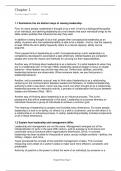Chapter 1
Thursday, August 22, 2024 7:33 AM
1.1 Summarize the six distinct ways of viewing leadership.
First, for many people, leadership is thought of as a trait. A trait is a distinguishing quality
of an individual, and defining leadership as a trait means that each individual brings to the
table certain qualities that influence the way they lead.
In addition to being thought of as a trait, people often conceptualize leadership as an
ability. A person who has leadership ability is able to be a leader—that is, has the capacity
to lead. While the term ability frequently refers to a natural capacity, ability can be
acquired.
Third, people think of leadership as a skill. Conceptualized as a skill, leadership is a
competency developed to accomplish a task effectively. Skilled leaders are competent
people who know the means and methods for carrying out their responsibilities.
Another way of thinking about leadership is as a behavior. It is what leaders do when they
are in a leadership role. In the late 1930s, leadership research began to focus on leader
behavior—what leaders say and the way they act. Unlike traits, abilities, and skills,
leadership behaviors are observable. When someone leads, we see that person’s
leadership behavior.
Another, and a somewhat unusual, way to think about leadership is as a relationship,
centering on the communication between leaders and followers. In traditional leadership,
authority is often a top-down, linear one-way event, but when thought of as a relationship,
leadership becomes an interactive activity, a process of collaboration that occurs between
leaders and followers (Rost, 1991).
Another way of thinking about leadership is as an influence process. This is the
perspective that will be emphasized in this book. Leadership is a process whereby an
individual influences a group of individuals to achieve a common goal.
The meaning of leadership is complex and includes many dimensions. For some people,
leadership is a trait or an ability, for others it is a skill or a behavior, and for still others it is
a relationship or an influence process. In reality, leadership probably includes components
of all of these dimensions.
1.2 Explain how leadership and management differ.
Leadership and management are not the same. Management emerged out of the
industrialization of work in the early 20th century, and its purpose is to structure and
coordinate various functions within organizations (Northouse, 2019). In contrast,
leadership has been studied for thousands of years, across multiple contexts—politics, the
military, religion, and more.
Taylor pioneered the concept of the scientific management of labor. This involved
measuring every detail of a worker’s tasks to make work more efficient, consistent, and
predictable.
Authority of position is the power to direct the work of an individual, by someone in a
higher position in an organization’s structure. Authority of leadership is not based on
Chapter Notes Page 1




